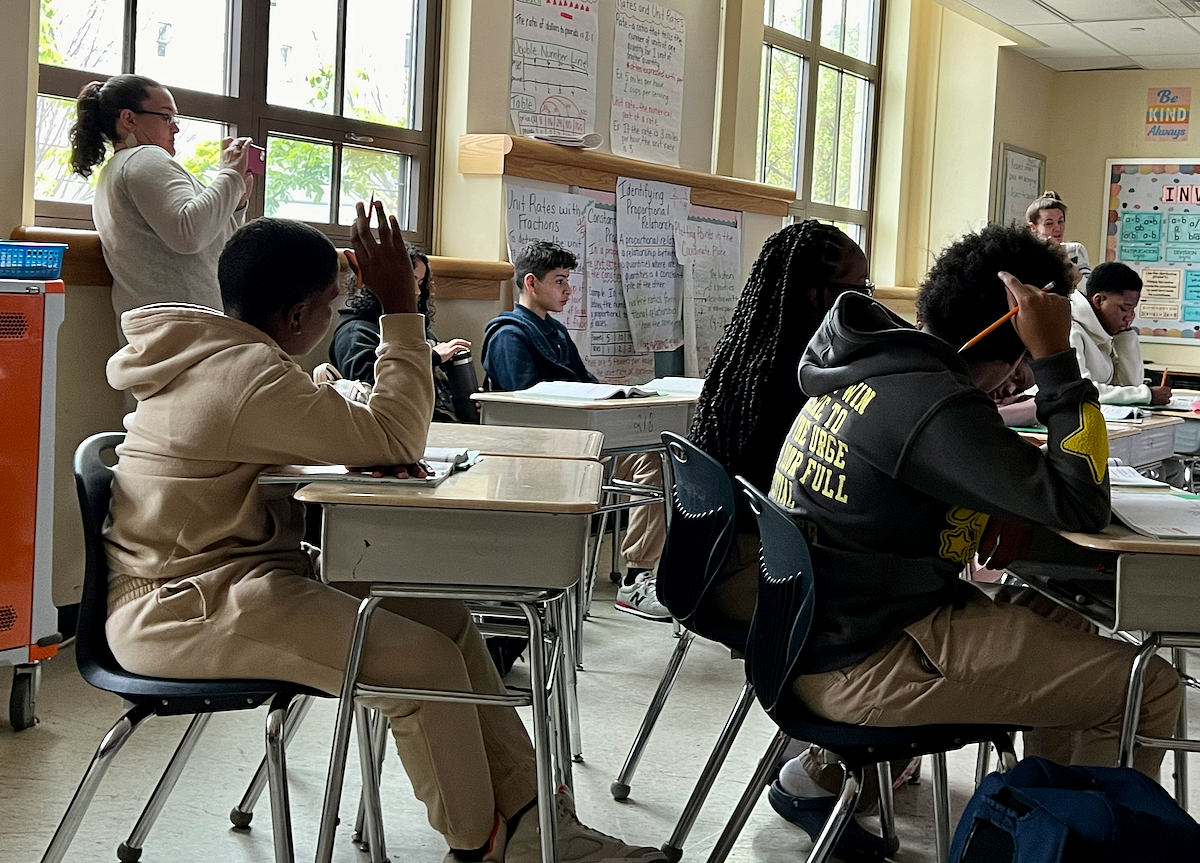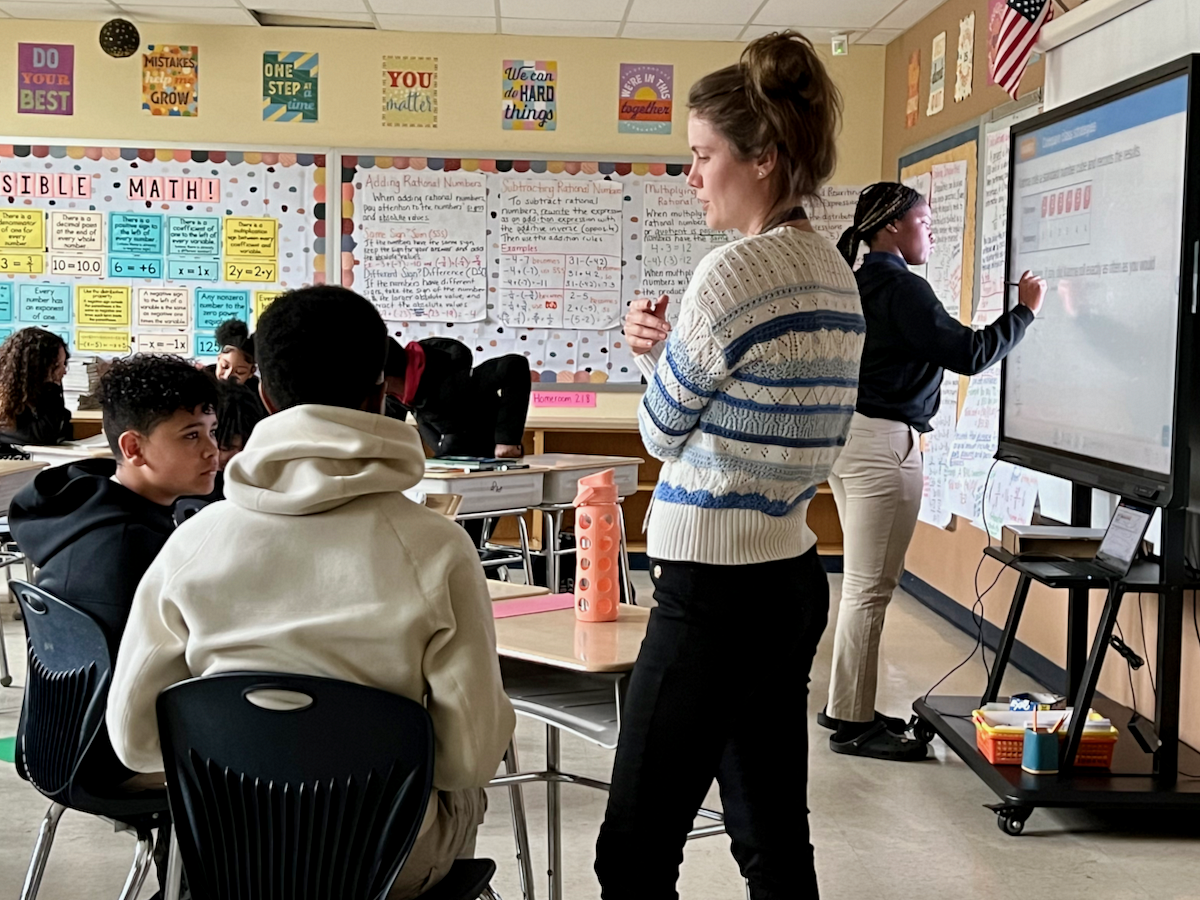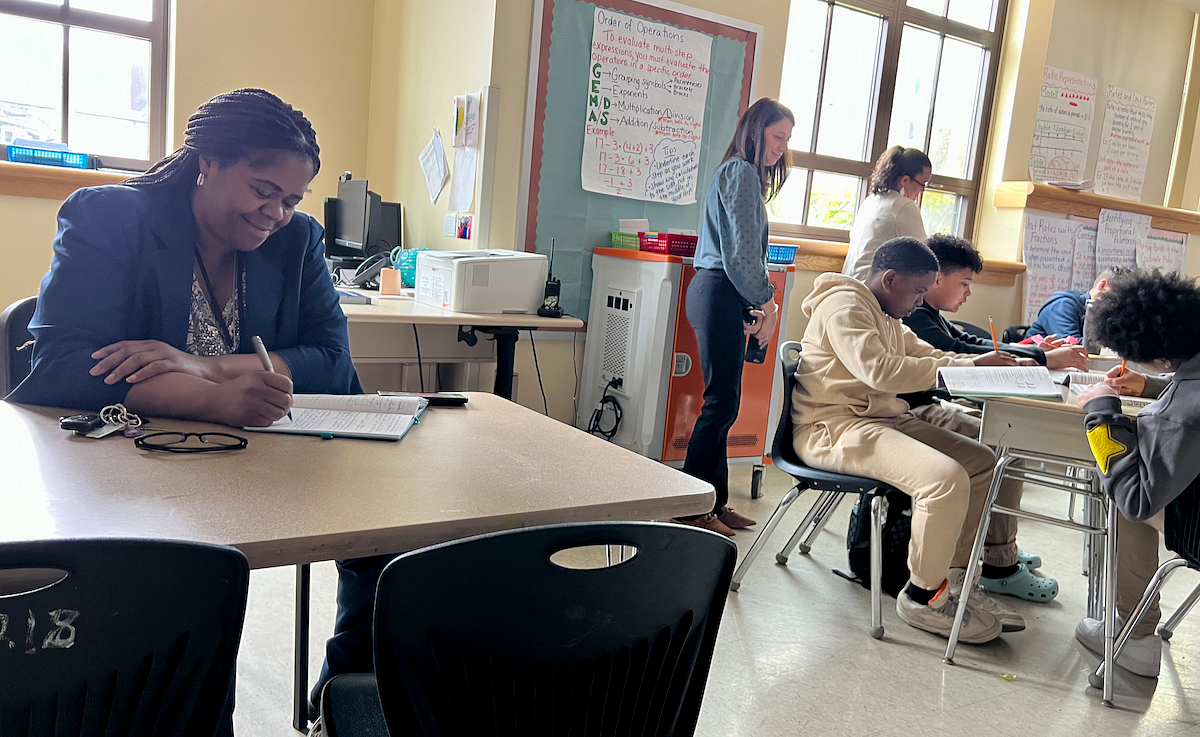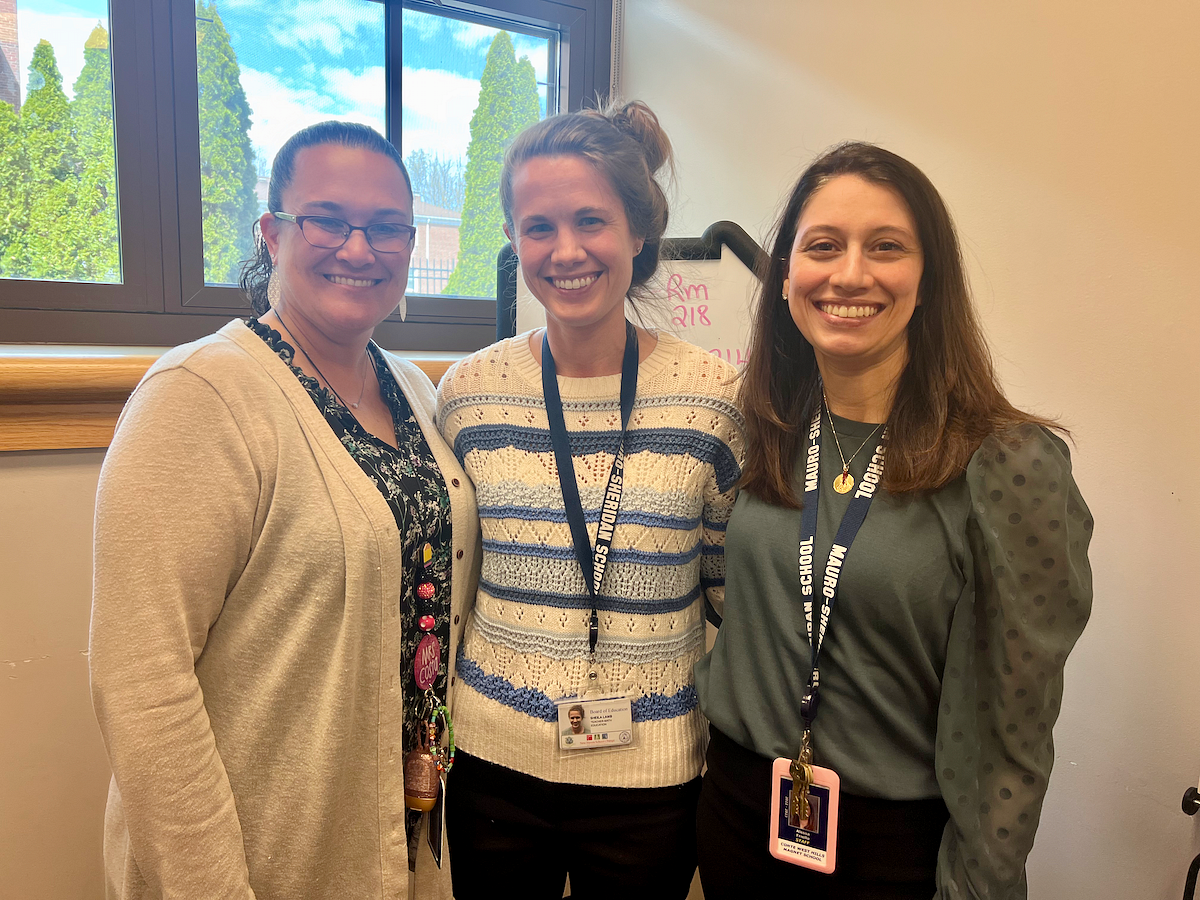
Maya McFadden photo
Sheila Lamb (right): "Your job right now is to be engaged."
As Mauro-Sheridan math teacher Sheila Lamb knocked on her seventh graders’ desks to urge them to participate in class, math coach Cortney Costa used her phone at the back of the classroom — not to play games, but to record Lamb’s model lesson.
That was the scene Wednesday morning in a second floor classroom at the 191 Fountain St. middle school, as New Haven Public Schools (NHPS) district math leaders made their latest stop around the city to take videos of exemplary math teaching methods and class lessons.
During Lamb’s first-period class Wednesday, NHPS Mathematics Coach Cortney Costa recorded parts of Lamb’s lesson and Math Department Supervisor Monica Joyner joined to take notes.
The video recording of Lamb’s class will make for the 18th video in the math department’s toolkit that all math teachers in the district can access and use to see how their colleagues address daily teaching obstacles.
Costa began recording classes and uploading edited videos to a shared drive for NHPS math teachers last year after staff expressed desires to see their own colleagues and students during professional development videos. The district acknowledged that typically professional development, or PD, videos show teaching lessons happening in different states and learning environments that aren’t similar to New Haven’s.
The video drive allows for NHPS educators to refer to teaching methods using the district’s recently implemented I‑Ready math curriculum at anytime.

Math on camera, at Mauro-Sheridan.
Wednesday’s lesson with Lamb’s seventh graders focused on identifying theoretical and experimental probabilities with six-sided dice.
Costa wandered the classroom full of posters reading “learn like a champion” and “we’re in this together,” documenting student work, conversations, and teaching methods.
Throughout Lamb’s 55-minute period, she regularly counted down from ten as students were instructed to turn to the next page of their workbooks and while moving around to work with partners.
In another tactic to keep her classroom running smoothly, efficiently, and with as much student participation as possible, Lamb selected students at random to read questions aloud or answer a question.
She also occasionally asked a second student to read a problem aloud again and then to put it into their own words to clarify what the question was asking.
At around 9:30 a.m., the class worked through a problem detailing two students who conducted experiments rolling a six- sided dice. The first did so 120 times, while the second did 450 trials. The student workbooks as well as the smart board at the front of the classroom displayed a table documenting the number of times each number of the dice was rolled for the set number of trials.
The class worked to find the theoretical probability of how many times the dice would land on each of its sides. They did so by dividing the number of trials by the number of dice faces. As a result the students found that the theoretical probability that the dice lands on each of its sides would be 20 times if 120 trials are done and 75 times on each side if 450 trials are done.
“That’s if we lived in a perfect world, so that’s why it’s theoretical probability,” Lamb explained.
Lamb then asked which of the experiments with 120 trials and 450 trials has the frequency numbers the closest to the expected theoretical probability numbers and why.
Students Marquese and Ahmed explained aloud to the class that the more trials conducted, the more possible chances there are of getting close to the expected frequencies for theoretical probability.
“The experiment’s random and it’s not always gonna be what you expect,” seventh grader Eva added.
Lamb concluded that with experimental probability chance is involved, while theoretical is what’s expected to happen based on calculations.
As the students continued through several pages of the workbook, Lamb tasked the students with reading the problem to themself to identify “what are key details we have to be paying attention to.”
“What is it asking you to determine?” Lamb asked after seventh grader Marquese re-read a question aloud to the class Wednesday.
Lamb then gave the class two minutes to work through the problem “silent and solo first” followed by another two minutes to work with a partner to see if they got the same answer and solved the problem in the same ways.
As students worked independently or with partners, Lamb provided the class with reminders aloud that during the two minutes “you should have number one done and be moving on to two soon.”
When asked how the two types of probability are different, several students explained that experimental probability uses results from an experiment while theoretical analyzes possible outcomes.

During a debrief session after Wednesday’s class, Joyner described noticing the structure of Lamb’s classroom that allowed students a routine while also moving around often. “I enjoyed the movement and procedures. It’s about giving them structure because even in middle school that’s what they’re looking for,” Joyner said.
She added that the students remained engaged even when unsure or wrong. “You can tell it’s a safe space to not know,” she said.
Throughout Lamb’s class Wednesday she used different methods to keep students engaged like giving students desk a light knock to let them know they would be called on next.
“It’s not optional to be learning and participating,” she said. “It’s ok to have the wrong answer but I tell them your job right now is to be engaged.”
Each class she attempts to call on every student or check in with students because “it’s not an option to be learning.”

District leaders visit Lamb's class.
The recording of Lamb’s work was not new to her, as she used to do the very same thing when she taught in the South Side of Chicago for ten years before coming to New Haven. She recalled in her first years of teaching setting up her own camera in the back of her classroom for ten minutes during a lesson to watch back and see how she can improve. She described the tactic as a “powerful tool for reflection.”
She was able to identify “what am I missing” and saw things like when she moved too fast or slow during a lesson.
Rather than being focused on showing a “perfect lesson” the video project focuses on showing educators how they can adapt lessons to classes to meet the needs of students and see how their colleagues are addressing common struggles.
“It’s helpful when you know what’s happening in your class is happening elsewhere,” Lamb said. “You can see how they problem solve.”
Costa edits each class video so they each offer a voiceover guiding other educators through the different teaching methods. “I don’t want to just throw video at them because when you’re already overwhelmed you may not notice everything.”
Costa added that the videos she records show authentic New Haven classrooms that allow for educators watching to see daily student personalities they likely work with too.
With each video, a contact for the portrayed educator is shared for colleagues to stay connected or ask for additional support. The videos allow for teachers to observe other classrooms without having to visit another school and make coverage arrangements, Joyner added.
Lamb added that as the only seventh grade math teacher at Mauro Sheridan she does not have a grade level partner to refer to, so the video collection has helped her to connect with others in the district and see how others implement the I‑Ready curriculum and resources.
Mauro Sheridan math coach Alessa Friello added that the videos are a non-intimidating way to collaborate and watch how others scaffold instruction. “It feels collaborative rather than you need to work on instruction,” she said.
Lamb agreed that the non-high stakes method has also given her the chance to watch back fifth and sixth grade lessons around the district to prepare herself at the start of the year for what her seventh graders may be familiar with in the classroom.
The goal, Joyner said, is to keep educators from feeling like they are alone on an island when it comes to meeting students where they are.

Cortney Costa, Sheila Lamb, and Alessa Friello.


My thoughts about math are divided. I tried hard to grasp it, but it just didn't add up and my anxiety multiplied.